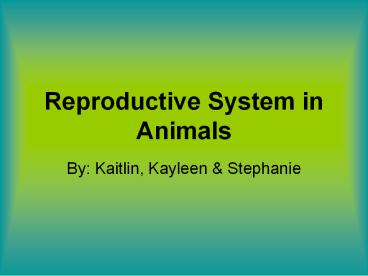Reproductive System in Animals - PowerPoint PPT Presentation
Title: Reproductive System in Animals
1
Reproductive System in Animals
- By Kaitlin, Kayleen Stephanie
2
Function
- Continue the existence of a species
- Individuals can multiply selves
- Reproductive tissue usually is separate one to
form a new organism - Cells sperm and egg join to produce offspring
3
How it works Asexual Reproduction
- Independent sexual reproduction that doesnt need
union of male/female germ cells - Uncommon, certain invertebrates can perform
4
Asexual Reproduction Continued
- Hermaphroditism one organism has both
reproductive systems to reproduce - Sequential hermaphroditism an organism changes
sex during its life - - produce offspring without mating
- Parthenogenesis an unfertilized egg to develop
and hatch (insects)
5
How it works Sexual Reproduction
- Union of 2 sets of DNA which usually comes from
different parents - Gonads organ producing
- reproductive cells, needed in process
- - Male testes produce sperm
- - Female ovaries make eggs
- Sperm need wet environment get to egg
- Must meet when gonads contain mature gametes
6
Porifera
7
Porifera
- Sexual sponges usually cross-fertilize one
another - Eggs and sperm join to produce a free-swimming
larva settles on surface (rocks) - Asexual gemules (internal buds)
- Small cuts of sponges reproduce into a
full-bodied sponge
8
Cnidarians
- Asexual/Sexual
- Most Jellyfish - both reproductive systems
- Multible Stages
- Polyp Stage larva settles to the bottom,
attaching self to a hard surface transforming
into a polyp
9
CnidariansEgg Stage and Poly Colony Stage
- Egg Stage Fertilized eggs develop inside the
female or in pouches on the oral arms - Larva is a short stage
- - leave mouth or pouch as
- free-swimming larva.
- Poly Colony Stage Polyp
- develops into a polyp colony kept
- together by feeding tubes
10
Cnidarians cont.Ephyra Medusa stage
- Polyp colony reproduce asexually and bud off tiny
free-swimming jellyfish (called Ephyra) - Ephyra grow in size and become adult Medusa (form
of jellyfish)
11
Platyhelminthes
- Flatworms hermaphrodites
- Eggs of each animal become fertilized from sperm
of partner - Eggs are laid in cocoons
- Yolk supplies
- with nourishment
- Thenhatch
12
Roundworms
- Reproduce sexually
- Separate sexes
- Chitinized spicules move
- into genital pore of the female.
- Sperm crawl along the
- spicule into female worm
13
Annelids Worms and Leeches
http//www.kidport.com/RefLIB/Science/Animals/Imag
es/Worms.JPG
14
Annelids
- Sexually
- - some external fertilization
- - some hermaphrodites (rarely fertilize selves)
- - two worms attach exchange sperm and store
in sacs until eggs ready to be fertilized - - mucus ring forms and a cocoon is produced to
hold embryos
15
Mollusks
- Sexually
- Male shed sperm into water
- Fertilization in body of female water flow brings
in sperm from male
16
Arthropoda Insecta
- Insecta separate sexes
- Reproduction is usually sexual
- - some eggs can develop without fertilization
by sperm
17
Arthropoda Crustacea
- Crustacea
- - Fertilization when eggs laid
- - egg sticks to the females swimmeret
- - carries eggs until developed/survive on own.
18
Arthropoda Arachnida
- Arachnida Sexual reproduction
- -Developing embryos protected until ready to be
born by - - egg case - cocoon - on female
19
Echinodermata
- Sexual reproduction
- Uses external fertilization
- Have separate sexes
20
Chordata Fish
- Sexually
- Female lays eggs
- Male fertilizes with a
- spray of liquid of
- sperm cells
- Yolk feeds the fish in
- the egg
21
Chordata Amphibians
- Reproduces sexually
- Eggs fertilized outside of the mother's body
- Father immediately comes by and fertilizes them
22
Chordata Reptiles
- Reproduces sexually
- Female's eggs fertilized by the male internally
- Egg then laid
23
Chordata Aves (Birds)
- Reproduce sexually
- Fertilization male place sperm in the female
- Bird lays eggs protective
- shell
- Male often help keep eggs
- warm until hatched
24
Chordata Mammal
- Reproduce sexually
- Female fertilized internally by male
25
Interesting facts
- In internal fertilization a female not willing
to mate often will injure/kill an aggressive male - In sea horses, the males become pregnant
- At five to six weeks of age male mice reach
puberty - Snails are hermaphrodites but still need to mate
to produce fertile eggs
26
Reproductive system interactions
- Only system not necessary for an individual
organism to live - Doesnt depend on any other system to work
- Endocrine system
- - hormones in the bloodstream
- - system that interacts with reproduction
27
Possible Test Questions
- What is the Purpose of the Reproductive System?
- Define and explain the two reproduction
processes? - True/False Hermaphrodites always reproduce with
self.
28
Answers
- What is the Purpose of the Reproductive System?
- Continue the existence of a species and for
individuals to multiply selves - Define and explain the two reproduction
processes? - Sexual 2 sets of DNA, Sperm must meet egg to
fertilize - Asexual Independent reproduction not needing
union of male/female cells - True/False Hermaphrodites always reproduce with
self. - False Sometimes mate with other animals
(Annelids) though have both parts
29
If Egg were to be fertilized.
Beginnings of embryo. As it grow, consume yellow
part yoke































